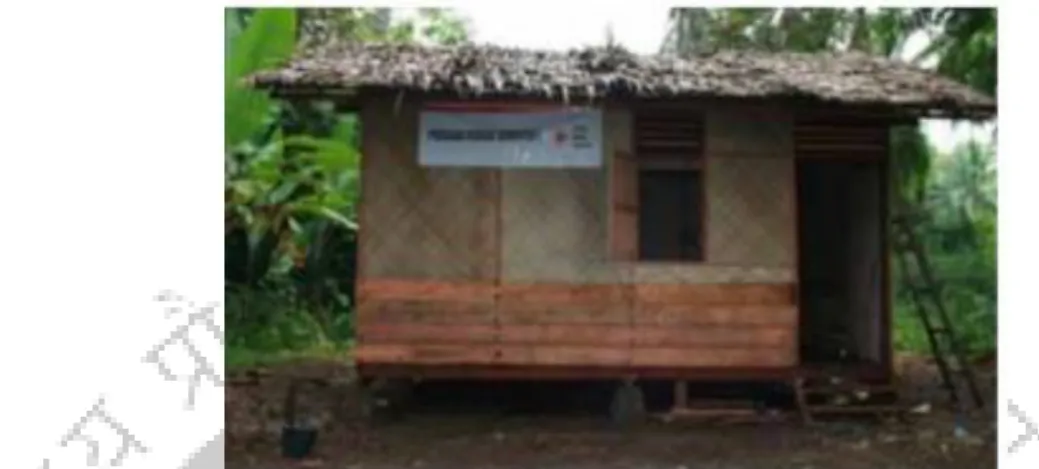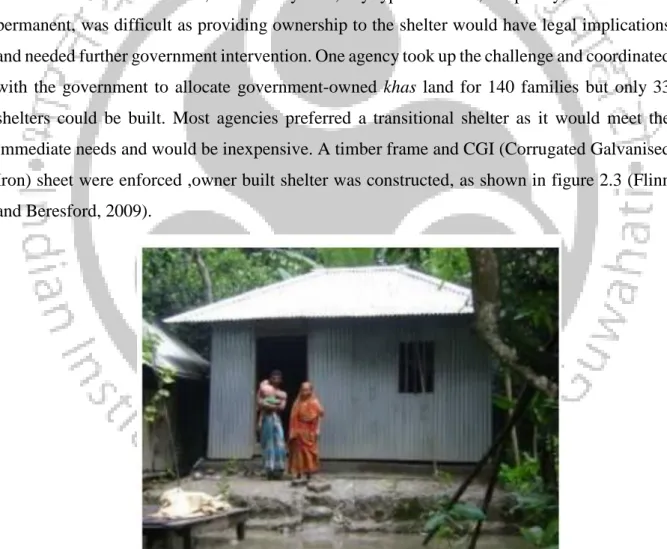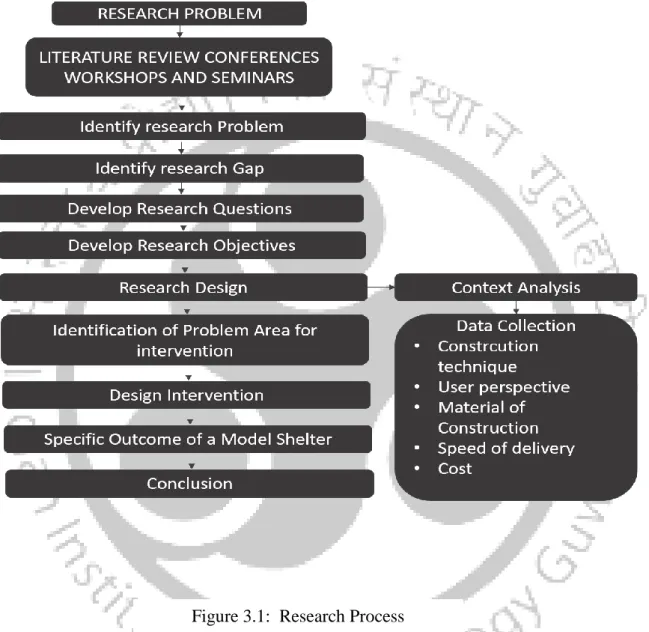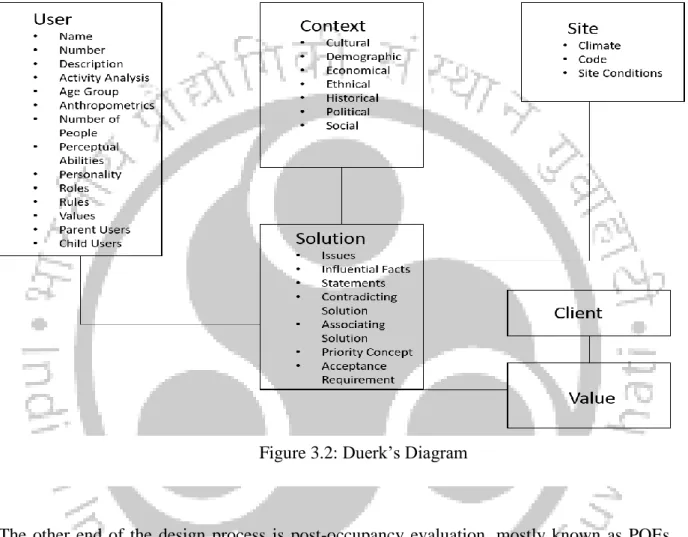Furthermore, an analysis is made to gain insight into the response of the accommodation to the disaster profile of the context. However, the storage of the shelter kit made of untreated bamboo proved to be a challenge.
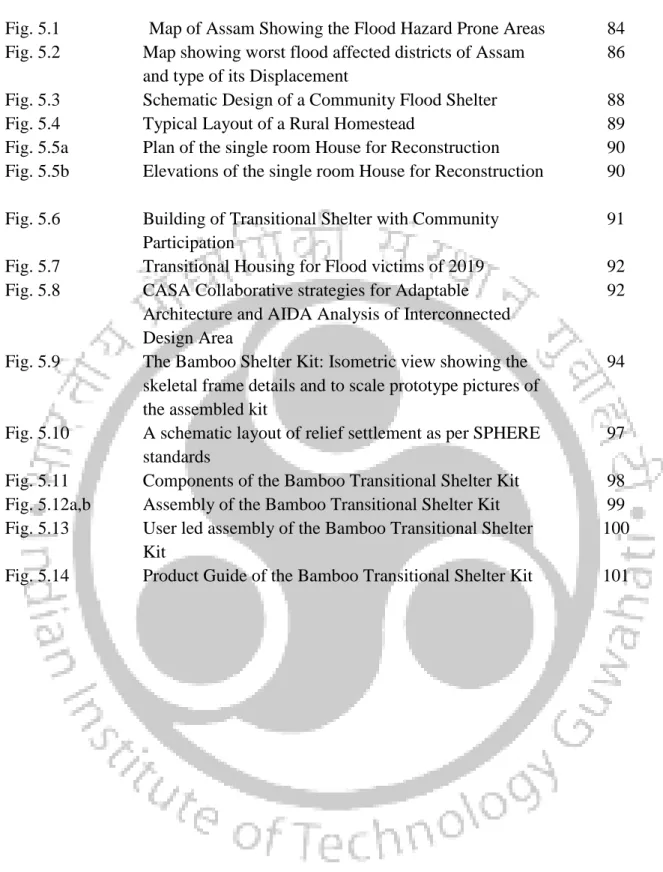
INTRODUCTION
- Transitional Shelter
- Definition: What is Transitional Shelter?
- Comparative study of Transitional Shelters 1. Findings of the Comparative Study
- Transitional Relief Settlements
- Motivation and prior study
- Problem statement
- Research Gap
- Aim and Objectives
- Research Questions
- Expected outcome
- Structure of the thesis The thesis consists of seven chapters,
However, the general guidelines for transitional shelters are available; the same was not considered for relief in the flood-affected areas of the Brahmaputra valley. The topography of the land must allow easy drainage and the site must be located above flood level.
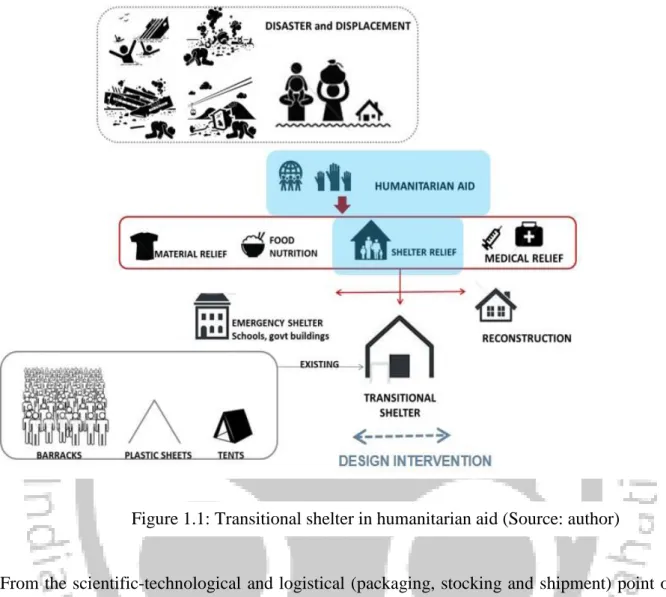
LITERATURE REVIEW
Sheltering and Housing Recovery Aftermath a disaster
This type of shelter is intended and built to be more permanent and upgradeable in the future through replaceable structural components (Saunders, 2013). Furthermore, no policy covers damage that occurs due to recurring annual floods in the exposed areas.
Evolution of Humanitarian Shelter Aid Design
From a humanitarian perspective, Shelter is seen as a housing process, and transitional shelter is an intermediate step in this process that contributes to reconstruction. Around this time we see the rise of mass housing in the form of apartment culture emerge.
Housing as a Manufactured Entity
After the Second World War marked the rise of non-governmental organizations (NGOs). However, the International Committee of the Red Cross was founded by Henry Dunant in 1860.
Study of transitional shelter in disaster-affected areas across the world
The design of the one-room shelter was based on brick columns and cement mortar. Humanitarian agencies, which are usually not local, are unaware of local needs and available resources. Coordinating with implementing agencies and assigning specific areas of work were an essential part of the local government's responsibility.
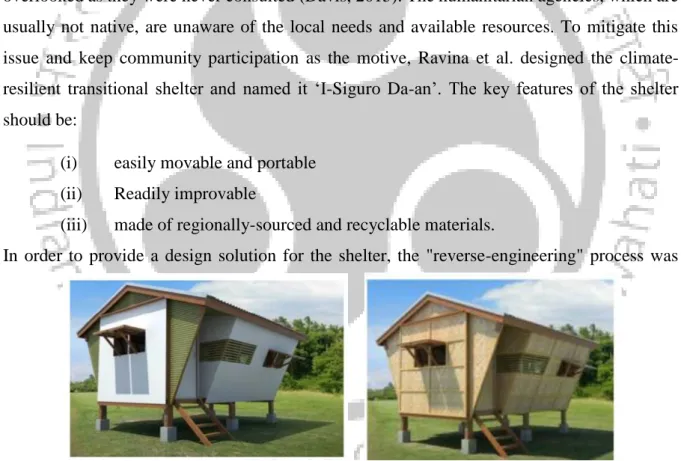
Flood in the Brahmaputra flood plain recurrence, siltation/ sand casting
Study of SPHERE Guidelines
To help achieve this goal, the Sphere Handbook recognizes that the affected population should be an integral part of decision-making, which is possible when the affected population has access to a safe haven/community during a disaster or conflict. Thus, depending on the shelter solution, shelter support items such as construction materials, tools and fasteners, and technical instructions should be part of the aid packages whenever needed. Whenever feasible, disaster-affected populations should be assisted with temporary shelter near their original homes.
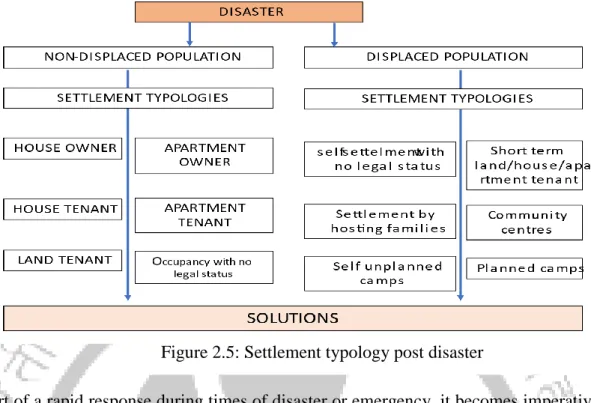
Available guidelines from National Disaster Management Authority
There is a need to understand the capacities of the affected families as they are very resourceful in how they build their homes, the local wisdom and other resources. Community involvement in the rebuilding process provides a sense of ownership that has also proven therapeutic. Sociotechnical facilitation of the reception process is not only a matter of specific tools and techniques, but requires a mindset and perspective to empower the community.
Findings from the literature survey
RESEARCH METHODOLOGY
- Choice of Research Method
- Research Design
- Qualitative Research Phase Data Collection
- Analysis of Documents
- Analysis of Data
- Design as Analysis and Evaluation
- Design as Action Research
- Design as a Learned Skill
- Design in Collaboration
- Episodic Ways of Relating Research to Design
Based on the rationale described in the previous section, a mixed method approach consisting of both a qualitative and a quantitative approach is used to answer the research questions and achieve the research objectives of the study. The other end of the design process is post-deployment evaluation, known as POEs. These raise the issue of the architect's role as designer in the larger context of the design process.
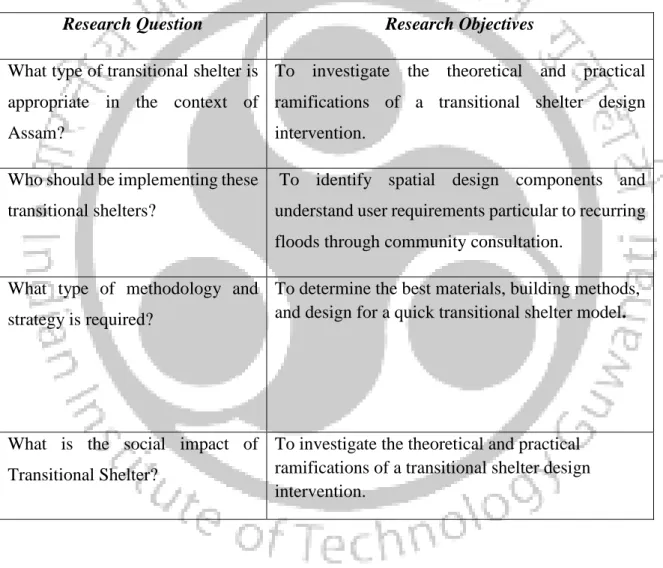
Geographical Location
According to the 2011 census, Nagaon district is the highest populated district of Assam and Dima Hasao is the least populated district.
Topography
Geology, Major Rivers and Soil Type
Climate, Temperature and Rainfall
Natural Hazard Profile of Assam
Many active faults such as the Himalayan Frontal Thrust, the Main Boundary Thrust and the Main Central Thrust exist in the region. From Figure 4.6 it is clearly seen that apart from Dima Hasao and Karbi Anglong area, which are mainly hilly, the rest of the districts in the plains and valleys are very affected by the Floods. Lack of proper land use development plan and rapid unauthorized growth of settlements in the hills are said to be the main cause of most of the landslides and its effect is seen in the frequent occurrence of landslides in the city (Ministry of Environment and Forests, 2011).
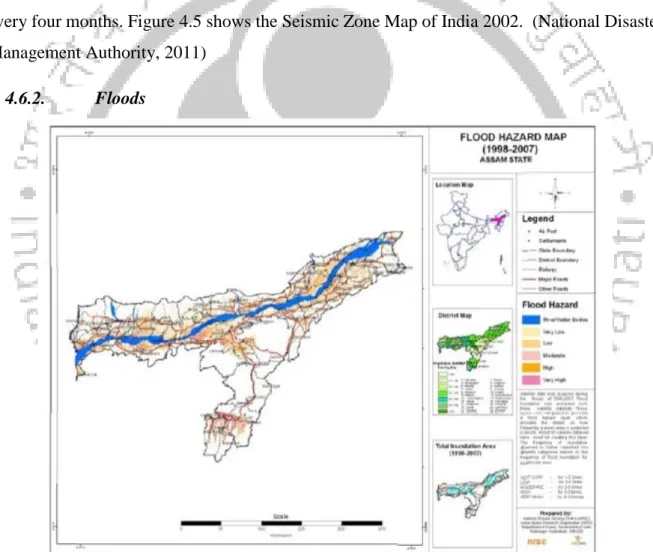
Build Typology in the State of Assam
In cities and urban areas, traditional style houses made of bamboo are often used by the economically weaker section of the people. Most of the houses in urban areas are either cement plastered burnt brick walls with profiled sheet roofs and or RCC. Buildings in urban areas have not maintained any conformity with each other, the lack of zoning and construction regulation at the local level has left the construction activity mainly available to individuals with limited advice from any professional.
Identified Building Typology
Since the walls are independent of the structure and fixed at regular intervals with timber framing and constructed with lightweight materials such as mud/cement plastered woven ikra/bamboo, these walls make flexible during earthquake shaking. This is a new typology that is being implemented in the flood prone areas of the state. The floor is created by stretching wooden beams on top of floor joists across the width of the structure.
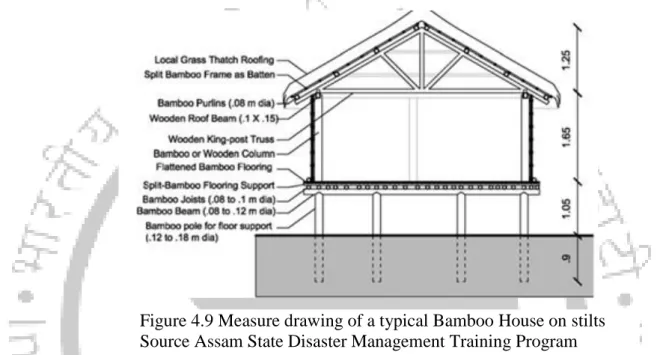
The Physical Study of a Flood Prone Settlement
At the settlement level, the streets act as the primary pedestrian and vehicular accesses. The bamboo bridge is an important access point to the settlement during the winter months, and during the summer people use boats (Rs 10 each way). At the settlement level, the biggest vulnerability is the loss of connectivity through the bamboo bridge, which is extremely fragile.
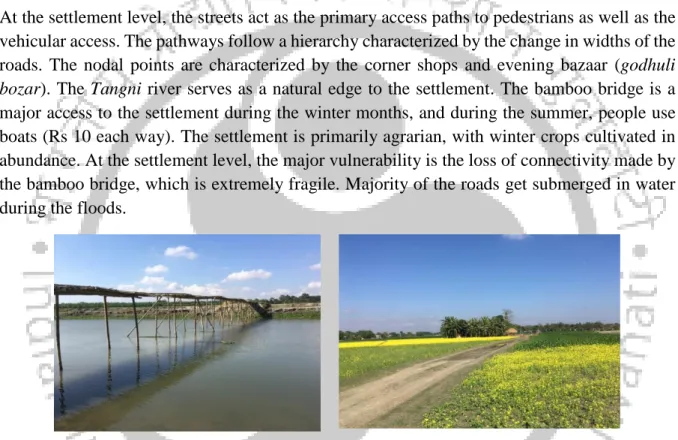
Introduction to Displacement Situation
The characteristic feature of the quarter houses at the building level is the Ikra-type walls, the different types of doors used based on the construction technique.
Choice of Material
The scale of the disaster and the duration of homelessness
In the second paradigm, disaster is seen as an expression of social vulnerability: a disaster is a situation involving damage and/or loss of life that exceeds a certain amount or number of deaths. In the third paradigm, disaster is perceived as a state of uncertainty created by institutions. Here, disaster is synonymous with the loss of public order and peace, making public safety the highest priority, regardless of the assessment of the phenomena that caused the problems.
Context of Research: The Brahmaputra Valley in the state of Assam, India
Therefore, one must consider not only the disaster limited to the threat of rain, but it is configured by social relations that extend the time and requirements for monitoring the reconstruction process. A good deal of planning, preparation and recognition of local factors are prerequisites for the success of the enterprise. A CoDesign exercise was conducted in one of the disaster sites to develop a housing model through community participation.
Shelter Design in the Context of Flood in Assam
In the first and second year of the research, we studied and reviewed the identified vulnerable location as indicated by stakeholders and NGOs; from these initial studies emerged the basic requirements of the conceptual plan, which include the participation of groups of people left homeless by the floods. In years three and four, the design development phases were done with community participation; design development where the design was carried out in specific locations and three-dimensional models were made and the technology was transferred to the participating groups.
Rural built typology in the study area
A prayer room and a granary, and usually a hay tower (maigi) for the cow shed. From the field study, we found that the flood-prone areas considered houses on stilts as flood-resistant features in some rural areas. However, due to the difference in the effect of flooding and cultural adaptation, houses on stilts are limited to only a few tribal areas.
Focused Group Discussions
Record the results of the investigation in the form of documents that can be further beneficial to society. Raise awareness of the event's potential impact and the importance of participants' own contribution, ideas and engagement during a disaster. Make people aware of the magnitude of the problem, its origins and indicators, and the need for cooperation.
Situation Study in Flood Shelters implemented in the State of Assam
Political advantage, the influential stakeholder may be interested in gaining publicity from the situation and thus become part of the community's participation. We are discovering that when individuals have control over the space they live in and their privacy needs are met, feelings of comfort and freedom are possible. Entirely agricultural, the community depended on the fertile soil on the banks of the Brahmaputra River.
Data survey about shelters in three stages
The third phase is investigations of the society's living conditions and habits during floods. In Dhansiri Chapori, which is a minority settlement, people have a necessary arrangement to relocate during the flood period, and in the case of Rajbongshi village, the settlement was completely washed away and the community needed permanent relief. A short questionnaire survey according to Appendix 1 was made to understand the spatial needs of the community.
Exploring Participatory Design
Because this can only happen during a flood and there has not yet been an opportunity to realize this phase of the research, this interaction has been replaced by the workshop. At the end of the testimonials, the theme of the participants was one of solidarity. They learn who to go to, where to get resources and transportation, or help repair infrastructure.
DESIGN EXPLORATIONS IN THE CONTEXT OF SHELTERS AFTER FLOODS
Design Exercise
Since annual flooding occurs during the hottest and most humid period of the year, a design solution for comfortable accommodation over the accommodation provided around government institutions in the form of tarpaulin/plastic sheet tents was required. From the study of a settlement which was completely eroded during the 2019 Brahmaputra Valley flood in Chirang district of Assam state in India, it was observed that the displaced people were forced to reside in a dilapidated community hall where women slept inside the hall at night. and the man was forced to sleep outside in an open area. First is the flood-affected region, where people have adapted to stilt houses and cohabiting with floods by moving to designated flood shelters in the form of multi-purpose stilt shelters, mainly in the tribal areas of Dhemaji and Lakhimpur districts. .
Design consideration and Area Programming for Proposed Multipurpose Flood Shelter in Assam
Annual floods in the Brahmaputra valley displace more than a million people, destroying their houses in whole or in part. The topography of the land should allow for easy drainage, and the site should be above the flood level, preferably on a raised platform. 465 m2 on the first and second floors and a facility for ramps to the first floor with a capacity of 400.
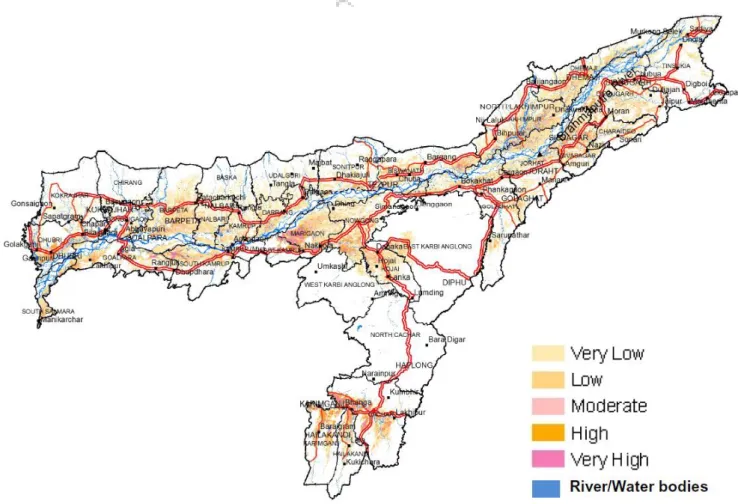
Design consideration and Area Programming for Reconstruction of individual Households
Co-Design Process
- Social Aspects
- Bamboo as the Material for the Shelter Kit
The lowest position of the roof within the shelter unit is considered to be a minimum of 1.8m. The shelter kit with more than 90% of the product as a natural material contributes minimally to the environmental degradation of the shelter site. The spatial, functional, humanitarian and technical aspect of the shelter set Principles adopted in the design;.
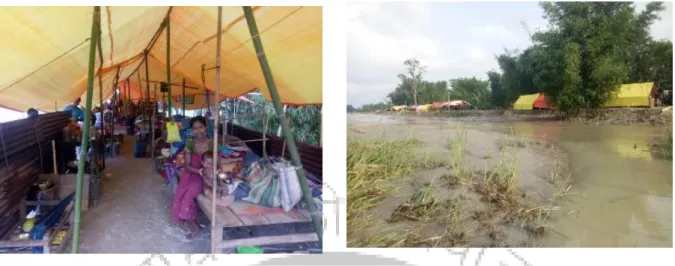
Enterprise development
The design of an assembly-based shelter package is the focus of this study, where a shelter package is a defined collection of shelter components, fasteners, and tools provided to meet the needs of the affected population at short notice. Kits can contain components to build a shelter, or contain some of the most essential materials for the shelter. In early 2020, the know-how of the shelter kit was transferred to DASTr NGO in Darrang, District where they accepted it as a suitable solution for the flood prone areas.
FINDINGS, RECOMMENDATIONS and CONCLUSIONS
- Limitations of the study include
- Research Validation
- Further Scope of study
- Recommendations
- Possible Economic impact of the research in Global terms
The research involved a comprehensive study of existing building typology in the flood-affected areas. Political affiliations are a practical prospect as they ultimately lead to success/failure in the use of the shelter in the truest sense. A shelter for victims of Typhoon Haiyan in the Philippines: Construction design and methodology.
Questionnaire for Study in Flood affected area
Did you spend extra on drinking water, milk, necessary medicine or transport costs to escape the flood.
Questionnaire for Study of Housing in Flood affected area
APPENDIX 3- Design Exploration using Bamboo Fibre Ferrocement Concrete
Pros and Cons of the Bamboo Transitional Shelter Kit
Sanction Letter of TOCIC, funding for the housing typology design
